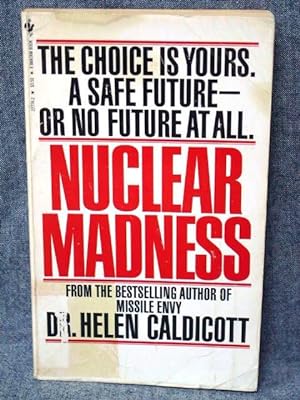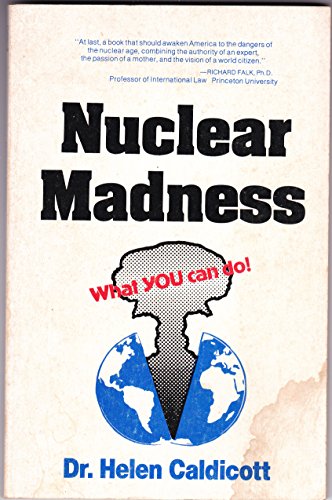caldicott helen herrington nancy stiskin (2 risultati)
Tipo di articolo
- Tutti gli articoli
- Libri (2)
- Riviste e Giornali
- Fumetti
- Spartiti
- Arte, Stampe e Poster
- Fotografie
- Mappe
-
Manoscritti e
Collezionismo cartaceo
Condizioni
- Tutte
- Nuovi
- Antichi o usati
Legatura
- Tutte
- Rilegato
- Brossura
Ulteriori caratteristiche
- Prima edizione
- Copia autografata
- Sovraccoperta (1)
- Con foto (1)
- No print on demand
Paese del venditore
Valutazione venditore
-
Nuclear Madness
Editore: Bantam Books, Inc., New York, 1980
ISBN 10: 0553227742ISBN 13: 9780553227741
Da: Past Pages, Oshawa, ON, Canada
Libro
Mass Market Paperback. Condizione: Fair. Second Edition 6th Printing. Previous Owner Markings/Ex-Library; Repaired; Inside Front Cover, 1st Page of Front Matter Pulled From Removal of Pocket, Sticker; Light Creasing on Front, Rear Covers; Front, Rear Covers, Spine Lightly Chipped; Light Sticker Pull to Front Cover; Light Moisture Damage (Staining); Edges Lightly Soiled; Moderate Yellowing Due to Age. THE CHOICE IS YOURS. A SAFE FUTURE - OR NO FUTURE AT ALL. FROM THE BESTSELLING AUTHOR OF MISSILE ENVY. SUB-TITLE: What You Can Do! With a new chapter on Three Mile Island. ALSO KNOWN AS: Excerpted in The Progressive, December 1978; and New Age Magazine, June 1978. A portion of this book appeared in Accidents Will Happen: The Case Against Nuclear Power by Environmental Action Foundation published by Harper & Row Publishers, Inc. 1979. The Epilogue first appeared in a slightly different form in Harvard's Political Review, Fall 1981. CONTENTS: Our Own Worst Enemy; Radiation; The Cycle of Death; Nuclear Sewage; Plutonium; M. A. D.; What You Can Do; Three Mile Island; Epilogue; Bibliography. SYNOPSIS: If we don't stop doing what we're doing, the air we breathe, the food we eat, and the water we drink will soon be contaminated with enough radioactivity to endanger you, your family and, in fact, all life on earth. NUCLEAR MADNESS Within the next ten years there could be a nuclear war which could kill up to 90% of Americans within thirty days. Nuclear war threatens us with the final medical epidemic for which there is no cure. Parents must take responsibility for their children's future and demand bilateral nuclear disarmament. WHAT SHOULD YOU DO? WHAT MUST YOU DO? You can no longer entrust your life to politicians, bureaucrats, or "experts." Because what they don't know . . . is killing you. Dr. Helen Caldicott - pediatrician, mother of three, concerned citizen - almost singlehandedly rallied the Australian protest which stopped French South Seas atomic testing. Now, in a concise, eloquent book which clearly describes the nuclear danger, she tells you exactly what you can do, what you must do now, to make your voice count against the nuclear madness. Australian-born and educated, Dr. Helen Caldicott practices pediatrics at Boston's Children's Hospital Medical Center. An environmental activist since 1971, she virtually single-handedly educated and inspired the Australian public to protest - and bring a halt to - French atmospheric testing in the South Pacific. She later worked tirelessly to inform Australia's labor unions about the medical and military dangers associated with the mining and sale of Australian uranium on the international market. Married and the mother of three children, Dr. Caldicott is now a permanent resident of the United States - where she is rapidly becoming a leading critic of the nuclear power and armaments industries. In Nuclear Madness, and in her frequent lectures and T.V. and radio appearances, she urges us all to become better informed about the nuclear hazards we face - and challenges us to take action to assure human survival on planet Earth. Size: 12mo - over 6¾" - 7¾" tall. Ex-Library.
-
Nuclear Madness: What You Can Do!
Editore: Autumn Press, Brookline, MA, 1979
ISBN 10: 0394736362ISBN 13: 9780394736365
Da: Ground Zero Books, Ltd., Silver Spring, MD, U.S.A.
Libro
Trade paperback. Condizione: Good. Condizione sovraccoperta: No DJ issued. Bill Burns (Cover illustration) (illustratore). Second Printing. 23 cm, 120, [2] pages. Wraps. Map. Footnotes. Bibliography. pencil erasure on first page, covers somewhat worn and soiled. Helen Mary Caldicott (born 7 August 1938) is an Australian physician, author, and anti-nuclear advocate. Caldicott's interest in nuclear issues was sparked when she read the 1957 Nevil Shute's book On the Beach, a novel about a nuclear holocaust set in Australia. In the 1970s, she gained prominence in Australia, New Zealand and North America, speaking on the health hazards of radiation from the perspective of pediatrics. Her early achievements included convincing Australia to sue France over its atmospheric testing of nuclear weapons in the Pacific in 1971 and 1972, which brought the practice to an end. In 1980, she founded the Women's Action for Nuclear Disarmament (WAND) in the United States, which was later renamed Women's Action for New Directions. It is a group dedicated to reducing or redirecting government spending away from nuclear energy and nuclear weapons towards what the group perceives as unmet social issues. Caldicott stood as an independent candidate for the House of Representatives at the 1990 federal election, contesting the Division of Richmond, against the Leader of the National Party, Charles Blunt. She polled 23.3% of the votes; not enough to win, but her preferences went mostly to the Labor candidate, Neville Newell, electing him and unseating Blunt. In 2002 Caldicott released The New Nuclear Danger, a commentary on the George Bush Military-Industrial Complex. Dr. Caldicott was a leader of the so-called "Ground Zero" movement that many accused of being naive and of advocating positions incompatible with United States national security interests vis a vis the Soviet Union during the late stages of the Cold War. First published in 1978, Helen Caldicott's cri du coeur about the dangers of nuclear power became an instant classic. In the intervening years much has changed . The Cold War is over, nuclear arms production has decreased, and there has been a marked growth in environmental awareness. But the nuclear genie has not been forced back into the bottle. The disaster at Chernobyl and the "incidents" at other plants around the world have disproven the image of "safe" nuclear power. Nuclear waste dumping has further poisoned our environment, and developing nuclear technology in the Third World poses still further risks.



